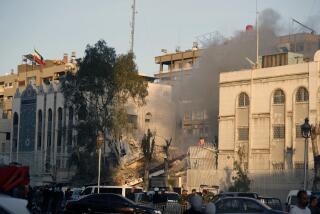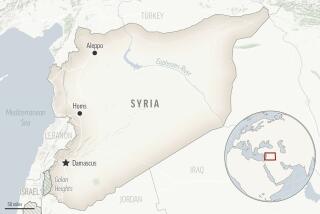In fog of Syria, observers can’t tell what they are seeing
When observers from the Arab League drove into this mountain town in southwestern Syria, a hotbed of dissent against President Bashar Assad, they received a hero’s welcome.
Residents mobbed the observers’ car, clamored to tell of their plight, and carried one of them away on their shoulders in celebration.
But just hours later, the five league representatives sped away under a hail of bullets. It was impossible to determine who was doing the shooting.
The episode Sunday was a rare, unsettling glimpse into the spiraling conflict that is threatening to plunge Syria into civil war and the challenges faced by about 160 monitors who are trying to verify wildly divergent versions of events under sometimes dangerous conditions.
Opposition activists and even some monitors have already declared the monthlong mission a failure, saying it was not given the time, the resources or the independence to determine whether the government is fulfilling its pledge to end a military crackdown that the United Nations says has claimed more than 5,000 lives since March. The government disputes the figures and says most of the casualties have been members of the security forces, who they charge are being targeted by foreign-backed terrorists.
In better times, Zabadani, a scenic town near the border with Lebanon, was famous for its cherry, apricot and apple orchards, and for the gracious summer homes built by members of the Syrian elite and wealthy visitors from the Persian Gulf.
Residents said that on Friday security forces surrounded the town and began pummeling them with tank rounds and gunfire.
“Kids are dying here and we can’t take them to the hospital,” one man said Sunday. “We’ve been three days without electricity or water.”
The five monitors, including representatives from the United Arab Emirates, Kuwait and Qatar, were dispatched to investigate what was happening.
Syrian officials, who are responsible for the mission’s security, informed the team that explosive devices had been found on the road to Zabadani and urged them not to go. If the observers insisted, they said, their security escort could not accompany them into the town, which residents acknowledge is defended by military defectors fighting under the banner of the Free Syrian Army.
It was not the first time they were presented with such a choice, the observers said. In some cases, they decided against a visit. This time they said they would see how far they could get on their own.
“With these things, we never know if it’s a real threat or they are just trying to keep us away,” one said. Like others interviewed, he asked not to be identified because the league has instructed the monitors not to speak to journalists.
They set off from Damascus in a speeding convoy full of armed security force members. Less than half an hour from the bustling streets of the capital, they entered an area that looked and felt like a front line in a war.
The road emptied of traffic and checkpoints dotted the way, manned by grim-looking officers in helmets and flak jackets with the occasional armored vehicle. About 15 miles outside Zabadani, the security escort peeled off. A car carrying the observers pressed on, stopping every few miles to ask residents and security force members what lay ahead.
At a checkpoint about 10 miles from Zabadani, an anti-riot police officer led the observers up a muddy path to a stable yard, to show them what he said were several recovered roadside bombs. They photographed what appeared to be rusty fuel canisters with wires attached.
“Where are the detonators?” an observer asked. The officer said he was not an engineer, but thought the canisters contained explosives.
As they got closer, the monitors came across families fleeing on foot and in cars with little or no luggage. Asked whether there was trouble ahead, a woman in a long black coat snapped back, “If there weren’t trouble, we wouldn’t be escaping.”
“We are walking now in the street and we don’t know where we are going,” said the woman, who asked to be identified only as Aisha, for fear of retribution.
The town appeared eerily deserted until the observers turned down a narrow street dubbed “Free Syria” in bold black graffiti on a wall. Young men raced into the road to clear away an improvised checkpoint and lead the vehicles to a small square where hundreds of people were waiting for them. The crowd erupted in cheers and chants.
Frantic men and women surrounded the vehicles, eager to tell their stories. Some carried photographs of the dead.
“My uncle was released from prison and shot the same day,” said a 12-year-old boy, who elbowed his way to the front of the crowd.
A 60-year-old man lifted his shirt to show what appeared to be burn marks on his stomach. “They arrested me and my son and four of my cousins,” he said. “This is from the electric shocks.”
In all, residents said, security forces had killed 14 people, injured 350 and detained 568 in a town of about 30,000 people since March.
“Till now they are around Zabadani,” said a bearded 67-year-old man, who said he was arrested with three sons. “They only left because of you and after an hour they will be back.”
Residents said they had been without water, electricity or phone service for three days. Leading the monitors to the edge of town, they pointed down a road where six armored vehicles could be seen in the distance. Go and look, they said, the security forces are hiding tanks in the bushes.
When the observers demurred and said they needed to leave, elements of the crowd started kicking and stoning their vehicle.
An elderly woman, her face framed by a dark scarf, leaned into the window of a journalist’s car and screamed: “They are slaughtering us. Protect us, for God’s sake.”
Afraid their car was about to be overturned, the observers sped off into the no man’s land between the town and the government checkpoint, a stretch of road less than a mile long littered with spent bullet casings. They approached carefully, exiting the vehicle and waving their distinctive orange vests in the air before getting too close to the government forces.
After several anxious moments, they were waved forward but then told there were suspicious wires in the road ahead and they could go no farther. Men who said they belonged to the anti-riot police dragged out the body of a colleague who they said had just been killed by armed gangs.
“This is the freedom they want?” an officer hollered. Others raised their guns and chanted, “Bashar, we sacrifice our souls and blood for you.”
When the observers asked about an approaching tank, the senior officer insisted: “It’s not a tank.... There’s a field hospital inside.”
They were held up at the checkpoint for an hour and a half as occasional gunfire cracked nearby. The officer held up his radio so the observers could hear colleagues at another checkpoint saying they were taking fire. Eventually, they were told that the army was on its way to “rescue” them.
When they were finally led away by an armored personnel carrier, there was an eruption of gunfire. Bullets zinged past the car windows, but it was not clear where they were coming from or who was the intended target. Another tank rolled by, headed to Zabadani.
By the time the members of the team reached their hotel, residents were calling their cellphones to report that the town was being shelled.
One observer said it felt as though the whole episode had been staged, but he could not say by whom. Did the townspeople push them forward to provide cover for an attack by the Free Syrian Army? Or were the security forces using them as an excuse to send in the army?
“We may never know what were the exact circumstances,” he said.
Special correspondent Rima Marrouch contributed to this report.
More to Read
Start your day right
Sign up for Essential California for news, features and recommendations from the L.A. Times and beyond in your inbox six days a week.
You may occasionally receive promotional content from the Los Angeles Times.






